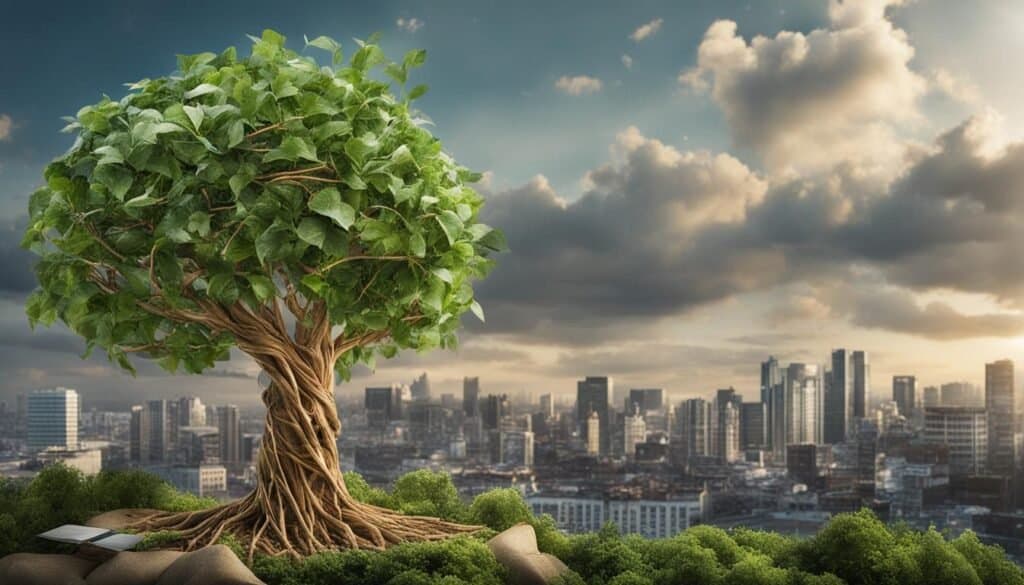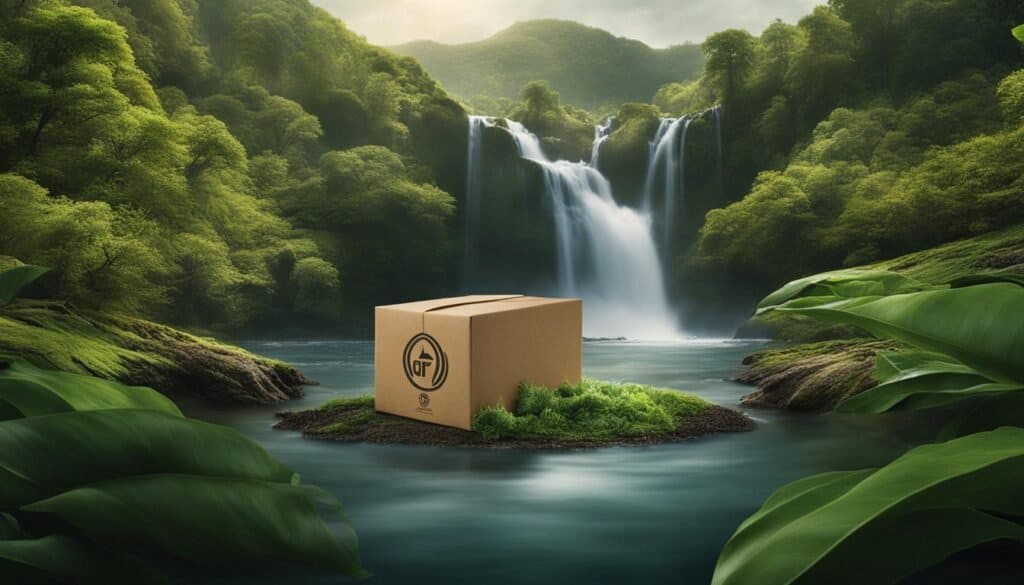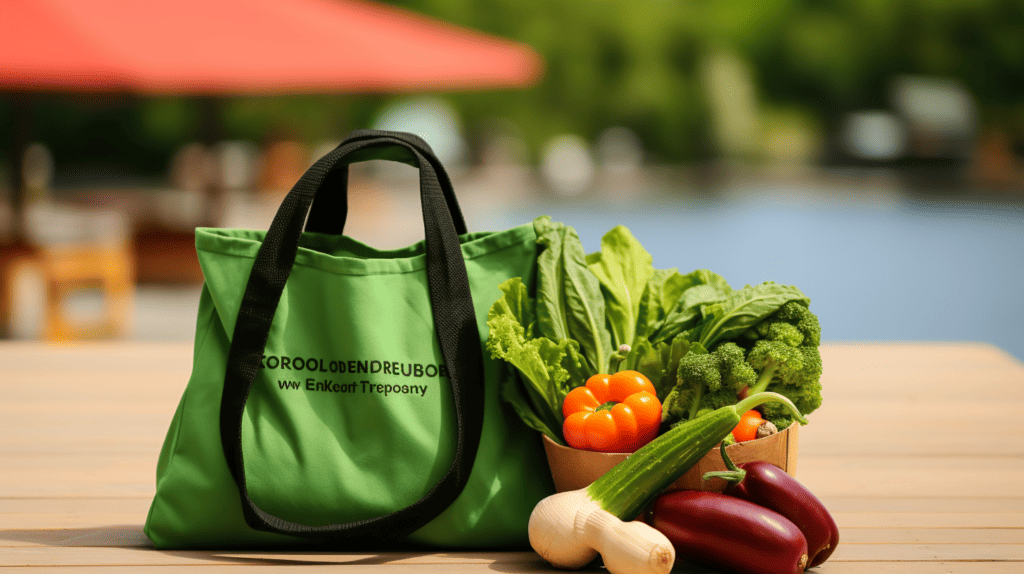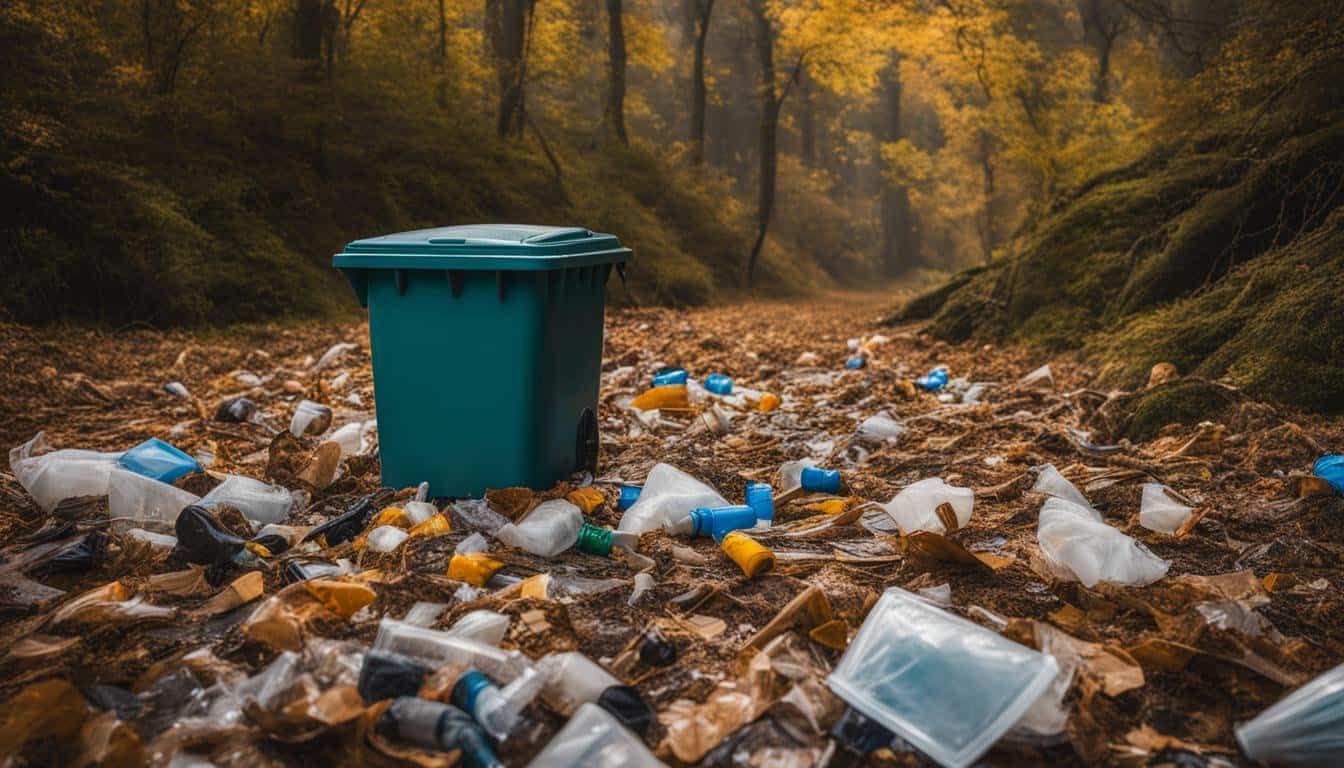In today’s world, the shift towards environmentally responsible choices is more critical than ever. For businesses, this means exploring sustainable packaging solutions for products and eco-friendly supplies. With a growing number of consumers making eco-conscious choices, businesses must prioritize sustainable packaging as part of their commitment to protecting our planet.
Sustainable packaging involves using materials and processes that minimize waste, conserve resources, and utilize either biodegradable or recyclable materials. Let’s dive into the world of modern sustainable packaging solutions and discover how adopting eco-conscious practices can benefit both the planet and your business.
Key Takeaways
- The demand for sustainable packaging solutions is rising as consumers prioritize eco-friendly choices.
- Switching to sustainable packaging can conserve resources, reduce waste, and minimize environmental impact.
- Businesses embracing eco-friendly packaging can enhance their brand reputation and customer loyalty.
- Choosing sustainable materials and processes is essential for future-proofing your business and aligning with consumer values.
- Adoption of sustainable packaging practices contributes to a circular economy and environmental stewardship.
Introduction to Sustainable Packaging and Its Importance
In today’s environmentally conscious world, the importance of sustainable packaging cannot be overstated. As opposed to traditional packaging methods, sustainable packaging takes a more eco-friendly approach, promoting minimal adverse effects on the environment. This is achieved through a comprehensive focus on the packaging material lifecycle, designed to conserve resources, reduce waste, and encourage responsible production and disposal practices.
By incorporating sustainable and eco-friendly packaging materials and processes, businesses can combat pollution, decrease their environmental footprint, and endorse ethical production techniques. This not only aids in the preservation of our planet but also fosters customer loyalty and elevates a brand’s reputation in an increasingly green-oriented consumer market.
“Sustainability in packaging is a vital aspect of reducing our impact on the planet and preserving valuable resources for future generations.”
So, what exactly does sustainable packaging entail? It covers aspects such as:
- The design and production of packaging materials that prioritize resource and energy efficiency;
- Utilization of renewable and recyclable materials, including biodegradable and compostable options;
- Adoption of clean, environmentally friendly production processes;
- Consideration of the packaging material lifecycle, from sourcing to disposal or recycling;
- Implementing responsible methods for disposal and waste management.
When businesses take these factors into account, they not only reduce their environmental impact but also cater to a growing demand for sustainable products and packaging options. In today’s market, eco-conscious customers are more likely to support brands that align with their values and prioritize the health of our planet. By embracing sustainable packaging, companies can not only show their commitment to environmental stewardship but also strengthen their position in the competitive marketplace.
The Environmental Impact of Traditional Packaging
Conventional packaging materials and methods have significantly contributed to pressing environmental concerns, such as pollution, resource depletion, and climate change. The vast use of non-renewable, non-biodegradable materials in the packaging industry has exacerbated the damage caused to our planet’s ecosystems and natural resources.
Pollution from packaging is particularly critical, as irresponsible disposal practices have led to widespread waterway and ecosystem contamination. Plastic debris, for example, poses a significant threat to marine life and has entered the world’s food chain, affecting not just animals but also humans. As a result, there is an urgent need to reconsider our packaging choices and adopt sustainable alternatives.
“The production and manufacturing of traditional packaging contribute heavily to the depletion of non-renewable resources and deforestation.”
Furthermore, the raw materials used for conventional packaging, such as plastic, aluminum, and paper, often originate from non-renewable resources, leading to rapid resource depletion. This pattern is especially evident in the case of deforestation for paper and cardboard manufacturing. Moreover, the extraction, production, and disposal processes involved in traditional packaging material development release large amounts of greenhouse gases, notably CO2, which contribute to the global issue of climate change.
Given these ecological challenges, it is imperative that businesses and consumers alike shift toward sustainable packaging practices. Below are some alarming figures that demonstrate the environmental impact of traditional packaging:
| Issue | Statistic |
|---|---|
| Global plastic waste generation (annually) | 300 million metric tons |
| Plastic waste found in oceans (estimated) | 8 million metric tons |
| Deforestation for paper production (annually) | 13 million hectares |
| Greenhouse gas emissions from packaging production (annually) | 3% of global emissions |
As awareness of the detrimental effects of traditional packaging continues to grow, businesses and consumers must work together to develop and implement sustainable packaging solutions that minimize environmental damage and combat climate change.
Exploring the 7 R’s of Eco-Friendly Packaging
As businesses and consumers continue striving for more eco-friendly practices, focusing on sustainable packaging becomes essential. Widespread adoption of packaging sustainability can significantly reduce waste and pollution, making it critical to explore the seven R’s of sustainable packaging: reduce, reuse, and recycle.
- Remove: This principle involves eliminating unnecessary packaging elements. By simplifying packaging and reducing its size and weight, we can minimize waste and resources used. For example, using a single box instead of double-boxing or removing plastic windows from packaging.
- Reduce: This is about minimizing the amount of material used. This can involve using thinner materials, smaller packaging, or more efficient designs that use less material while still protecting the product. For instance, using a thinner but strong cardboard for a product box.
- Reuse: Encouraging the reuse of packaging can significantly reduce waste. Packaging designed for multiple uses or secondary functions can have a prolonged life. For example, a glass jar that can be reused for storage, or a cloth bag that can be used for shopping.
- Renew: Using renewable resources for packaging materials is a key aspect. This means sourcing materials that are replenished naturally over time, like bamboo, corn starch, or paper from sustainably managed forests.
- Recycle: Designing packaging that can be easily recycled helps to ensure that materials are recovered and reused. This includes using materials that are widely accepted in recycling programs and designing packaging that can be easily disassembled for recycling.
- Rethink: This principle involves reimagining packaging strategies. It’s about innovating and finding new, more sustainable ways to package products. This could involve using digital labels instead of physical ones, or using new materials that are more sustainable.
- Responsibility: This final principle is about taking responsibility for the entire lifecycle of the packaging. Companies should consider the environmental impact of their packaging from production to disposal and work towards minimizing this impact.
By applying these principles, companies can make their packaging more eco-friendly, reducing their environmental footprint and often also reducing costs associated with packaging materials and waste management.
Innovative Materials in Sustainable Packaging

The continuing demand for sustainability has led to various sustainable packaging materials and eco-friendly packaging innovations, offering renewable packaging solutions, recyclable and compostable materials in place of traditional options. These new materials have helped to reduce environmental impact and shift towards more sustainable options.
Plant-based compostable packing peanuts are an excellent example of a material that can replace harmful styrofoam. These packing peanuts are made from starch and break down in water, minimizing their environmental footprint. Mushroom compostable packaging, made from the fibrous root structures of mushrooms called mycelium, serves as a highly sustainable alternative to plastic packaging for fragile products. Moreover, microfibrillated cellulose, derived from wood pulp, is a renewable and recyclable material with versatile applications in enhancing product packaging strength and performance.
Aluminum, being lightweight and extraordinarily recyclable, is more frequently utilized for containers, especially in the food and beverage industry. Seaweed packaging solutions are innovative and biodegradable, presenting new possibilities for the future of food packaging. In contrast, fully recyclable polyethylene options provide an alternative to traditional plastics, which are non-recyclable and pose a threat to the environment.
| Material | Description | Environmental Benefit |
|---|---|---|
| Cornstarch packaging | Derived from a renewable source of corn, these materials can be utilized for packaging that dissolves in water or breaks down in a composting environment | Biodegradable and compostable, emits fewer greenhouse gases during production |
| Composted mushroom packaging | Created from mycelium and agricultural waste, this packaging is entirely biodegradable and compostable in a matter of weeks | Reduces reliance on petroleum-based plastics and minimizes landfill waste |
| Glassine wood pulp packaging | Transparent, grease-resistant paper made from wood pulp, serving as a potential replacement for conventional plastics | Recyclable, biodegradable, and sourced from renewable materials |
These innovations in sustainable packaging materials represent significant steps toward reducing the environmental impact associated with conventional packaging. By adopting these eco-friendly alternatives, we can help encourage a transition towards a greener, more circular economy and healthier planet.
The Benefits of Switching to Eco-Friendly Packaging for Businesses

As more businesses recognize the importance of sustainability, transitioning to eco-friendly packaging has become a crucial aspect of brand strategy. This shift presents numerous potential benefits beyond environmental conservation, positively impacting brand reputation, customer loyalty, fiscal incentives, and cost-effectiveness.
“Eco-friendly packaging can reinforce a positive company image and align businesses with consumer values, attracting a loyal customer base.”
Brand Reputation: Businesses that choose eco-friendly packaging demonstrate their commitment to environmental sustainability and social responsibility. This decision contributes to an improved brand image, as today’s consumers increasingly prioritize sustainability and expect companies to share these values.
Customer Loyalty: Adopting sustainable packaging practices helps cultivate and maintain customer loyalty by aligning businesses with their customers’ environmental concerns. Prospective clients are more likely to favor eco-conscious brands and make repeat purchases, resulting in long-term business growth.
Government Incentives: Many governments offer incentives and subsidies to companies that embrace eco-friendly practices, including eco-friendly packaging initiatives. By incorporating sustainable packaging, businesses can qualify for special rebates, tax breaks, or grants designed to encourage sustainable innovation.
| Benefit | Description |
|---|---|
| Brand Reputation | Demonstrating a commitment to environmental sustainability and social responsibility, attracting eco-conscious customers |
| Customer Loyalty | Cultivating long-term relationships with clients and customers who value eco-friendly practices |
| Government Incentives | Reaping the advantages of rebates, tax breaks, or grants by adopting eco-friendly methods into packaging solutions |
| Cost-effectiveness | Minimizing long-term costs through more efficient packaging materials and designs |
Cost-effectiveness: Implementing eco-friendly packaging can also result in cost savings for businesses. By optimizing material usage and minimizing waste, companies can reduce long-term expenses and improve overall profitability.
In conclusion, the benefits of utilizing eco-friendly packaging extend beyond environmental impact, strengthening brand reputation, fostering customer loyalty, securing government incentives, and promoting cost-effective business practices. Consequently, the pursuit of sustainable packaging solutions is not only a wise eco-conscious choice but also an advantageous business decision that aligns with the values and expectations of modern society.
Consumer Influence: The Power of Eco-Conscious Choices

As awareness surrounding the environmental impact of conventional packaging materials grows, consumer influence on packaging has become an increasingly important driving force for change. As customers prioritize their eco-conscious purchasing decisions, the demand for sustainable materials and alternative packaging solutions intensifies. Such decisions can have a profound impact on corporate packaging practices, pushing companies to meet the expectations of a growing eco-conscious market.
To make informed choices, consumers can educate themselves on the various sustainable packaging options available, as well as understanding the importance of packaging material lifecycle. By opting for products with minimal environmental impact, consumers send a strong message to businesses, encouraging them to adopt more sustainable practices.
Through informed decisions and prioritizing products with minimal environmental impact, consumers can ignite significant changes in corporate packaging practices, encouraging businesses to cater to a growing eco-conscious market.
Here are some ways consumers can wield their influence and contribute to greener packaging efforts:
- Support brands that prioritize sustainable packaging and share their eco-friendly values
- Advocate for change by voicing concerns and suggesting eco-friendly alternatives to businesses that continue to use traditional, non-sustainable packaging materials
- Share knowledge with friends, family, and the wider community to increase the overall demand for sustainable packaging solutions.
Businesses keen on catering to this eco-conscious consumer base need to provide more sustainable options. Here’s a quick comparison of some popular sustainable materials versus traditional counterparts:
| Sustainable Materials | Traditional Materials |
|---|---|
| Biodegradable materials (e.g., PLA, PHA) | Non-biodegradable plastics (e.g., PET, PVC) |
| Plant-based packaging (e.g., cornstarch, mushroom) | Oil-based plastics (e.g., polyethylene) |
| Recycled paper and cardboard | Virgin paper and cardboard |
| Aluminum and glass containers | Single-use plastic containers |
When consumer influence on packaging standards is strong and supported by a growing awareness of eco-conscious choices, businesses will have little choice but to adapt to demand and embrace sustainable materials and practices. By making educated decisions, buyers can play a significant role in shaping the future of packaging and promoting a sustainable and eco-friendly world.
Identifying and Choosing Sustainable Packaging Options
As a consumer, it’s essential to recognize and select eco-friendly packaging for the products we buy. To help in identifying sustainable packaging, there are several factors to consider, such as the materials used, the packaging design, and certification labels. By actively choosing eco-friendly options, we contribute to conserving resources and reducing pollution, while supporting human health and protecting the environment.
One of the primary aspects to look for in sustainable packaging is the use of recyclable materials. Materials such as cardboard, paper, glass, aluminum, and recyclable plastics are considered sustainable, as they can be reused or repurposed, reducing the need for virgin materials.
Another way to identify eco-friendly packaging is by analyzing the design. Minimalistic and lightweight packaging consumes fewer resources, creates less waste, and requires less energy to produce. On the contrary, packaging with excessive layers or single-use components is most likely not environmentally friendly.
Certification labels also serve as reliable indicators of sustainable packaging. The Forest Stewardship Council (FSC) certification is one such recognizable label, indicating that the product is made from responsibly managed forests. It ensures that the production and sourcing of the material consider long-term ecological, social, and economic impacts. Look out for the FSC logo on paper and cardboard packaging.
Another certification to consider is the How2Recycle label. This label simplifies the recycling process by providing clear instructions on how to recycle each component of the packaging. By following these instructions, consumers can ensure the appropriate disposal of materials, preventing them from ending up in landfills or waterways.
Choose packaging with recognized certifications like FSC and How2Recycle labels to support eco-conscious decisions.
In conclusion, to select sustainable packaging options, prioritize products with the following features:
- Recyclable materials
- Minimalistic and lightweight designs
- Forest Stewardship Council (FSC) certification
- How2Recycle label
By actively identifying and choosing sustainable packaging, we can contribute to the global effort to protect our planet and preserve resources for future generations.
Success Stories: Brands Leading the Charge in Sustainable Packaging

As our world evolves towards embracing more sustainable practices, a variety of brands, both large and small, have taken bold steps in pursuit of eco-friendly packaging solutions. Let’s take a look at some of the corporate innovators and trailblazing small businesses making significant strides in packaging sustainability.
Corporate Innovators in Packaging Sustainability
Among the leading sustainable brands in the quest for innovative eco-friendly practices are industry giants like Unilever, Coca-Cola, and Nestlé. Their commitments to sustainable packaging implementation have positively influenced other companies to follow suit and contribute to community-driven initiatives.
“We’re excited to invest in new packaging innovations to scale up the number of products we sell in refillable formats and reusable packaging,” Unilever CEO, Alan Jope.
Unilever intends to ensure 100% reusable or recyclable plastic packaging by 2025, while Nestlé aims to establish 100% recyclable or reusable materials by the same year. Coca-Cola also plans to create bottles made entirely from recycled materials by 2030.
Small Businesses Making Big Changes
Small businesses have showcased their dedication to sustainable packaging, serving as key driving forces for industry-wide change. Many of these ventures have adopted innovative eco-friendly practices, creating unique and eco-conscious products while supporting community-driven initiatives.
- EcoNuts – A company producing all-natural laundry detergent packaged in compostable boxes, which also fund reforestation projects.
- EcoEnclose – Eco-friendly packaging supplier focused on providing businesses with 100% recycled shipping materials, including mailers, boxes, tapes, and labels.
- Pela Case – Innovative creators of plant-based, compostable smartphone cases that reduce plastic waste caused by traditional protective cases.
The success stories of these corporate innovators and trailblazing small businesses demonstrate that significant ecological impacts can be achieved through creative packaging solutions and community-driven initiatives. Their efforts contribute to building a more sustainable future for both our planet and society as a whole.
Strategies for Reducing Packaging Waste in Supply Chain Management
Adopting eco-friendly packaging within supply chains is pivotal for waste reduction and overall environmental sustainability. Employing strategies such as selecting biodegradable materials, embracing recyclable plastics, and designing minimalistic packaging is aligned with wider ecological objectives and the principles of a circular economy. In this section, we’ll explore several supply chain management strategies that can help reduce packaging waste and foster sustainable supply chains.
- Select Biodegradable Materials: One effective way to reduce packaging waste is to use biodegradable materials. These materials decompose naturally, leaving little to no trace of their existence, and are much less harmful to the environment than traditional plastics and packaging materials. Examples of biodegradable packaging materials include paper, cardboard, and compostable plastics made from starch-based polymers.
- Embrace Recyclable Plastics: Another effective strategy for reducing packaging waste is to use recyclable plastics, which can be reprocessed and transformed into new products. These eco-friendly packaging practices help to minimize landfill waste and contribute to a more circular economy. Examples of recyclable plastics include PET (Polyethylene Terephthalate) and HDPE (High-Density Polyethylene).
- Design Minimalistic Packaging: Utilizing minimalist packaging is yet another strategic method to curtail packaging waste. By reducing the amount of material used in packaging, businesses can save resources and generate less waste. Aiming for lightweight, compact, and streamlined design principles will make a significant difference in overall waste reduction.
- Implement a Packaging Waste Audit: Periodically auditing the packaging waste within your supply chain can help you identify potential problem areas and give you the feedback needed to refine your eco-friendly packaging practices. A thorough audit will highlight areas where too much material is being used, giving you the chance to redesign packaging, consolidate shipments when possible, and eliminate unnecessary wastage.
Notable companies have successfully reduced packaging waste by implementing these sustainable supply chain management strategies. For example, IKEA has ordered a reduction in the use of plastics in its packaging, using biodegradable materials and environmentally-friendly adhesives. Similarly, Amazon has introduced its Frustration-Free Packaging initiative, which uses 100% recyclable materials and reduces excess packaging materials.
“Sustainable packaging and supply chain management strategies are not just about helping the environment. They can also lead to cost savings for businesses and offer a competitive advantage in an increasingly eco-conscious consumer market.”
In summary, reducing packaging waste within supply chain management should be a priority for businesses looking to embrace sustainable practices, protect the environment, and meet the rising demand for eco-friendly packaging practices. By implementing the strategies discussed in this section, businesses can contribute positively to the reduction in packaging waste, ensuring a more sustainable future for all.
Future Trends in Packaging: What’s on the Horizon?
As the packaging industry evolves, future packaging trends demonstrate a continued progression towards innovative materials and designs that emphasize environmental protection. The sustainability horizon is an exciting space filled with new technologies and creative approaches, aiming to revolutionize packaging solutions. Let’s take a look at some of the most promising upcoming eco-friendly packaging solutions that not only respect the planet but also elevate consumer experiences.
- Organic ecological textiles: Thewendungrese sustainable and biodegradable textiles can be used in various packaging applications to reduce waste and the consumption of non-renewable resources.
- Edible films: Manufactured primarily from biopolymers and proteins, these safe-to-consume and environmentally-friendly packaging alternatives reduce plastic consumption and food waste.
- Reusable packaging solutions: A significant shift towards reusability aims to extend the life cycle of packaging materials, promoting a circular economy and ensuring greater resource conservation.
These innovations signal a broader commitment to environmentally conscious practices within the packaging sector. As companies and consumers alike continue to prioritize sustainability, the market for eco-friendly packaging solutions is set for substantial growth.
“The packaging industry is a creative and fast-paced field, where new ideas, technologies, and designs have the potential to make a positive global impact on both the planet and our daily lives.”
Adopting an environmentally focused approach in packaging choices is not just about minimizing harm; it’s also about creating new opportunities and solutions that add value to the market, products, and the consumer experience. As we move forward, we can expect even more groundbreaking developments in packaging materials and design, fostering a sustainable future that benefits generations to come.
Conclusion on Sustainable Packaging Solutions
As we look toward the future of sustainable packaging and eco-friendly solutions, it’s clear that environmental stewardship must rank as a top priority. Through innovative materials, improved designs, and responsible practices, businesses stand poised to make a lasting positive impact on our planet.
Companies that adopt sustainable packaging strategies aren’t just benefiting the environment—they’re also setting themselves up for success as consumer demand for eco-conscious options increases. This commitment to sustainable practices reinforces a brand’s dedication to environmental responsibility, ultimately contributing to the growth and stability of a circular economy, benefitting all involved.
By embracing sustainable packaging solutions, we can each play a crucial role in preserving the environment for generations to come. As we continue to innovate and explore new eco-friendly possibilities, the future of packaging looks bright, underpinned by a shared commitment to sustainability and social accountability.
FAQ on Sustainable Packaging Solutions for Products
Q: What are some examples of sustainable packaging solutions for products?
A: Some examples of sustainable packaging solutions for products include compostable packaging, recyclable packaging, packaging made from eco-friendly materials, and custom packaging designed with environmentally friendly materials.
Q: Why is it important for businesses to utilize eco-friendly packaging products?
A: Using eco-friendly packaging products is important for businesses because it demonstrates a commitment to sustainability, meets the increasing demand from environmentally conscious consumers, and helps reduce the environmental impact of packaging materials.
Q: How can businesses find sustainable packaging companies to meet their packaging needs?
A: Businesses can find sustainable packaging companies by conducting online research, reaching out to industry organizations focused on sustainability, attending trade shows and events, and seeking recommendations from other businesses who have successfully implemented sustainable packaging solutions.
Q: What materials are commonly used for sustainable packaging?
A: Common materials used for sustainable packaging include recycled paper and cardboard, biodegradable plastics, compostable materials such as plant-based PLA and bagasse, and reusable packaging options like glass jars and metal tins.
Q: How can businesses make a strong business case for investing in sustainable packaging?
A: Businesses can make a strong business case for investing in sustainable packaging by highlighting potential cost savings through reduced material usage, appealing to environmentally conscious consumers, differentiating their brand in the market, and reducing the risk of non-compliance with future environmental regulations.
Q: What are some packaging examples that demonstrate eco-friendly materials being used?
A: Some packaging examples that demonstrate eco-friendly materials being used include custom boxes made from recycled cardboard, edible packaging made from natural ingredients, and flexible packaging that’s made from biodegradable materials like plant-based plastics.
Q: What are the key considerations for business owners when looking for sustainable packaging supplies?
A: Key considerations for business owners when looking for sustainable packaging supplies include the compatibility of the packaging solution with their products, the environmental impact of the materials, cost-effectiveness, and the ability to align with the brand’s sustainability goals.
Q: How can businesses optimize their packaging to be more environmentally friendly?
A: Businesses can optimize their packaging to be more environmentally friendly by right-sizing packaging to reduce material waste, using packaging made from renewable resources, incorporating recycled materials, and educating consumers on responsible disposal or reuse of the packaging.
Q: What are some sustainable packaging solutions that are particularly suitable for the food industry?
A: Sustainable packaging solutions particularly suitable for the food industry include compostable food packaging, recycled packaging for food products, and edible packaging options that reduce waste and offer sustainable alternatives for packaging perishable goods.
Q: How can businesses ensure that their packaging isn’t contributing to environmental degradation?
A: Businesses can ensure that their packaging isn’t contributing to environmental degradation by choosing packaging materials that are certified as sustainable, assessing the full life cycle of the packaging, and seeking transparency from packaging suppliers about the sourcing and environmental impact of the materials used.





Leave a Reply